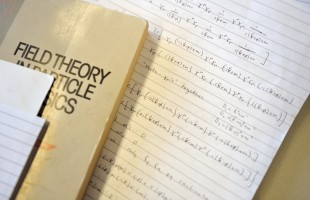As of 1 September, Nikhef-physicist Juan Rojo has been appointed Professor of Theoretical Physics at the Vrije Universiteit Amsterdam. His chair is embedded in the Physics and Astronomy department.

Rojo studied Physics at the University of Barcelona in Spain, where he obtained his doctorate in 2006. Subsequently he worked as postdoctoral researcher in Paris, Milano, and at the European Organization for Nuclear Research (CERN). In 2013 he started working at the University of Oxford and as lecturer at Balliol College. Rojo joined the VU and Nikhef in 2016, first as assistant professor and since 2019 as associate professor.
Some of his recent achievements include demonstrating that gluons contribute to the proton spin, finding evidence for the existence of intrinsic charm quarks in the proton, and unveiling a novel dynamical regime of the strong nuclear force where gluons dominate at high-energies.
Fascinating proton
Rojo: “The proton is a fascinating example of the unique beauty of quantum mechanics: what a proton is ‘in itself’ depends strongly on the resolution at which we image it! As we improve our theory simulations and statistical analysis techniques, we can obtain a more and more refined picture of the proton, addressing fundamental questions such as the origin of its mass and its angular momentum, and whether it contains novel constituents in addition to those we learn about in textbooks.
“If you think about it, it is quite remarkable: everything around us is essentially made up by protons, they are one of the most abundant particles in the universe, and yet after a century of extensively studying the proton we keep discovering novel and unexpected aspects of this charming particle.”
Machine learning
Rojo’s research has a two-fold motivation: on the one hand, deepening our understanding of the inner life of protons, on the other hand, providing robust predictions for high-energy processes involving protons.
Rojo: “From the Large Hadron Collider at CERN in Geneva to gigantic neutrino detectors in the Antarctica, a wide range of particle and astro-particle physics experiments demand a solid understanding of the quark and gluon substructure of the proton. By applying cutting-edge machine learning methods to the interpretation of high-energy data, I am able to extract information that would otherwise remain inaccessible.”
In the coming two decades, several new experiments will keep testing to an unprecedented level our current picture of the proton. “The best is yet to come: using electrons, neutrinos, and protons themselves as energetic quantum projectiles combined with AI methods, we will be able to achieve the ultimate imaging of protons by mapping the quantum universe at the zeptospace, resolving distances a billion times smaller than the size of an atom itself.”
(Source: VU news release)
